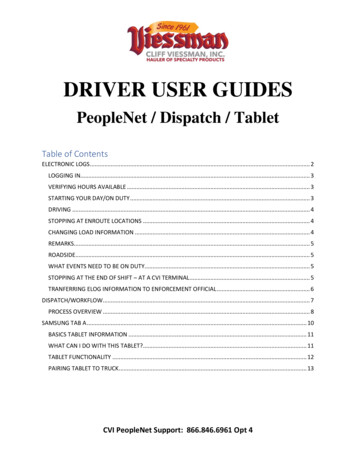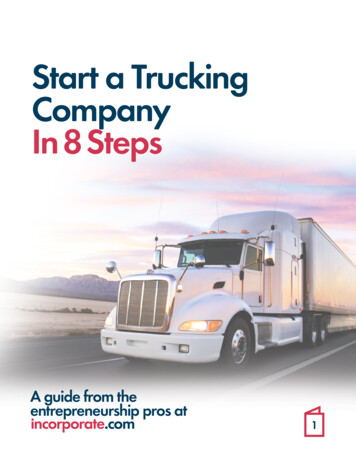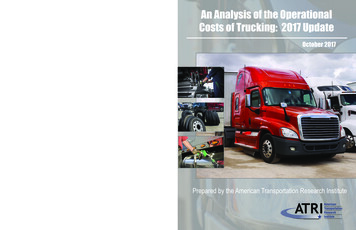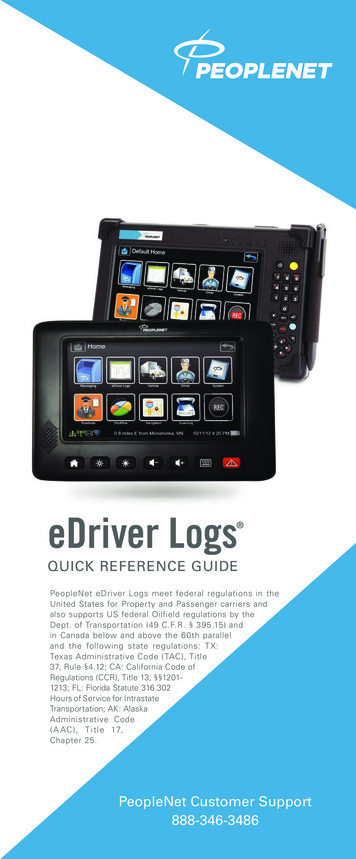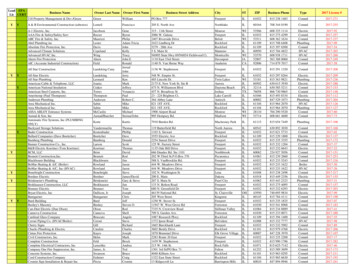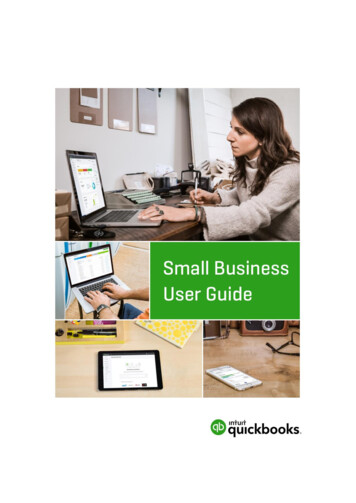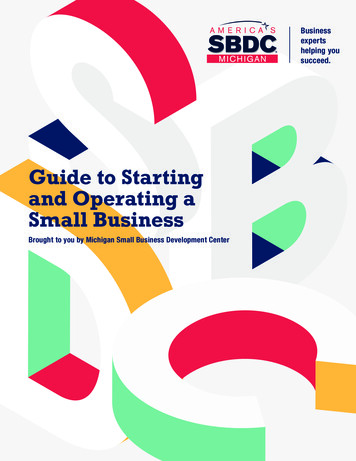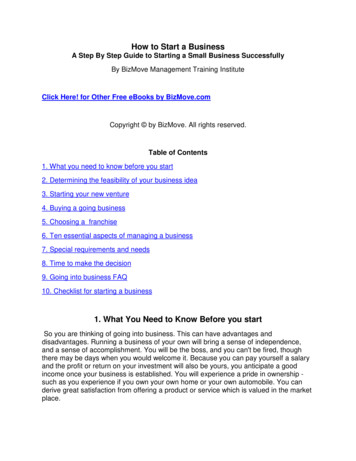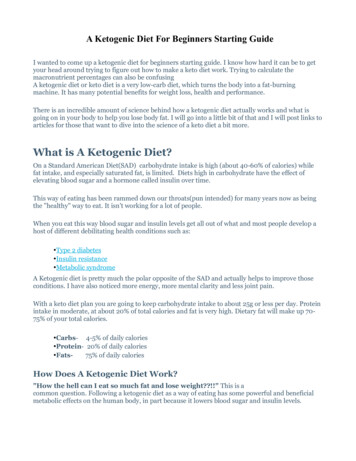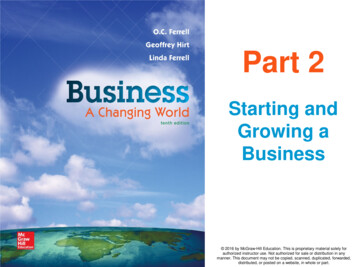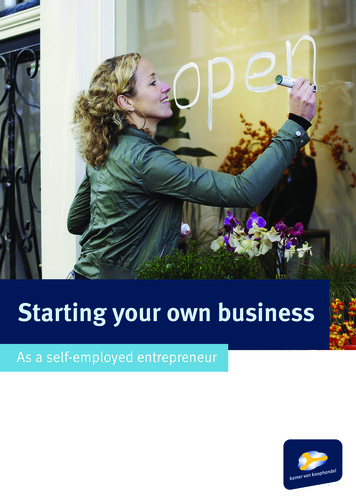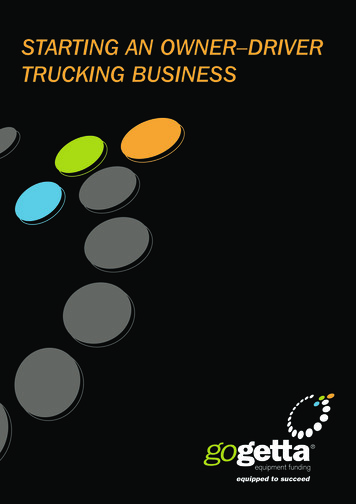
Transcription
STARTING AN OWNER–DRIVERTRUCKING BUSINESS
CONTENTSIntroduction3Setting up your business4Business structure4Business registration5Insurance5Taxation5Permits and licences6Getting finance7Rent-to-own7Chattel mortgage8Finance lease8Cash10Applying for funding10Choosing a truck11Price11New vs second-hand12Key features12Expert advice13Finding work14Hirers15The contract16Managing your finances17Keeping a cash book18Cash-flow budget18Staying in business20Customer service20Vehicle maintenance21Fuel economy22Recordkeeping23Conclusion24Business age 2gogetta – Starting an owner – driver trucking business
INTRODUCTIONThis e-book, Starting an owner–driver trucking business, aims to help would-be owner–drivers setup and run a trucking business. It provides a summary of some of the things you need to be awareof and do.You probably already know how to drive a truck. But as you’ve probably guessed, running abusiness is a lot different to being simply an employee.While the potential rewards — personal and financial — are greater, there are more challenges andrisks involved in running your own trucking business.This e-book — based on existing industry guides (see ‘References’ at the end of the document)and insights gathered from interviews with truck drivers, dealers and finance brokers — is intendedto help you make more informed decisions and improve your chances of success.There are numerous aspects to setting up and running a trucking business. We’ve identified thekey ones you need to consider, namely:Settingup yourbusinessStaying ng atruckFindingworkgogetta – Starting an owner – driver trucking businessPage 3
SETTING UP YOUR BUSINESSAccording to business.gov.au (2014), planning should always be the first step in developingyour business.A business plan is a document that describes your business, its objectives, strategies, targetmarket and financial forecasts.It gives your business direction and helps you prepare for the things you’ll need to do to securework, grow and prosper.Developing a business plan forces you to think through all the aspects of the business, includingits strengths, weaknesses, opportunities and threats (SWOT analysis).It will involve some research on your part, however the effort will be worth it as the plan will saveyou time and money in the long run.Bear in mind that your business will depend on the health of the businesses you serve. Forexample, a downturn in housing will affect the transportation of building supplies (this would formpart of your SWOT analysis — see ‘Business tools’ section below). An example SWOT analysis canbe found in the business tools section at the end of this ebook.So you’ll need to be on the look out for things that will affect your customers and plan accordingly.Review your business plan quarterly — as your business changes, your strategieswill need to evolve to ensure your business stays on track.BUSINESS STRUCTUREThe way you set up your business will affect how it is managed and the way you pay tax (WesternAustralian Department of Transport (WADoT) 2012).Most owner–drivers operate as sole traders, whereby they accept full responsibility for everyoperational and financial aspect of the business.However, while they have complete control and ownership and receive 100 per cent of the profits,they are personally exposed to all the commercial risk.Other business structures include partnerships and limited liability companies (see ‘Businesstools’ section below).Before deciding on the best business structure for your operation, talk to your accountantor other professional advisor, who will be able to explain the pros and cons of each.Page 4gogetta – Starting an owner – driver trucking business
BUSINESS REGISTRATIONWhen you have decided on a business structure, you can ask your lawyer or accountant to help youregister your business name.An Australian Business Number (ABN) is not compulsory, but the positives of having one faroutweigh the negatives.INSURANCEAccording to the WADoT (2012), it’s important to protect your assets, including your truck andtrailer, by taking out appropriate and adequate insurance cover.Insurance can be arranged through an insurance company, insurance agent (who acts for theinsurance company) or insurance broker (who acts for you).The broker’s job is to compare a range of policies and find the best one for you.Do not sign anything until you fully understand the terms and conditions of the insurance contract.There are several types of insurance, including comprehensive motor vehicle, public liability andincome protection. For more information, talk to your broker.Make sure you disclose all the facts that could influence the insurancecompany’s decision to accept the risk or in calculating the premium. If youdon’t, any future claim could be rejected.gogetta – Starting an owner – driver trucking businessPage 5
TAXATIONYou’ll need a tax file number for your business, otherwise you’ll be taxed at the highest marginaltax rate.Under Australian Tax Office (ATO) rules, businesses with a turnover of more than 50,000 per yearmust register for goods and services tax (GST).A GST-registered business must charge its customers GST on the taxable goods and servicesit provides.However, the business is entitled to a credit for any GST it has paid for its expenditures on thesegoods and services as well as capital purchases (called input tax credits).In addition, businesses that employ staff must register as a Pay As You Go (PAYG) withholdingpayer.You may also be liable for state taxes, including payroll tax, land tax and/or stamp duty.Ask your accountant to confirm what you must do to comply with allAustralian Tax Office (ATO) requirements, as non-compliance can lead tofinancially crippling penalties (WADoT 2012).PERMITS AND LICENCESAs you probably know, there are numerous regulations governing things like gross vehicle weight/combination masses, axle loadings and driving hours.Find out which government licences, permits, approvals, registrations, codes of practice, standardsand guidelines you need to know about to meet your compliance responsibilities.A good place to start would be your state’s transport department.Special permits are needed for the transportation of dangerous goods and vehicles that exceedregulation mass and/or size limits.Make sure you have the correct driver’s licence for the category of vehicleyou will be driving, otherwise you could be heavily fined and/or your vehiclecould be confiscated.Page 6gogetta – Starting an owner – driver trucking business
GETTING FINANCEVery few wannabe owner–drivers have the money to pay cash for a truck. Consequently, they haveto borrow the money from a lender.Even if you have enough cash to buy a truck outright, it may be wiser to get it financed through athird party. That way, you will have more cash on hand to meet your operating costs until you getpaid (see ‘Managing your finances’ section below).The best person to advise you about financing your business is your accountant or licensedfinance broker.They will be able to advise you on how different types of finance will affect your set-up and runningcosts and tax bill.If you’re unsure how to find a licensed broker, there are well-known broker associations, such asCAFBA, that can help you find one.RENT-TO-OWNThe finance company purchases the asset you require and then rents it to you.You then use the vehicle for an agreed time in return for regular, fixed rental payments.It means you avoid high upfront investment costs and improves your short-term cash flow.The rental payments are fully tax deductible. In addition, you may be entitled to claim an input taxcredit for the GST contained in your rental payments.At the end of the rental contract you have a number of choices, including continuing to rent thevehicle at an adjusted rental amount; buying it for the residual amount owing; or returning it if nolonger needed.Although rent-to-own may sound identical to a finance lease (see below), there are somefundamental differences.In contrast to a finance lease (and chattel mortgage - see below), rent-to-own: allows you to hand back the vehicle to the finance company at the end of the contract if it nolonger suits your needs — no questions asked allows you to pay for the vehicle in full at any stage of the contract without penalty is ‘off balance sheet’, which means your business equity — and capacity to borrow more money— is unaffected generally has a shorter duration — you’re not locked into a long-term contract.Rent-to-own is particularly suited to start-up businesses as the vehicle funder typically does notrequire a trading history or director guarantees.gogetta – Starting an owner – driver trucking businessPage 7
CHATTEL MORTGAGEOne of the most common forms of truck finance is a chattel mortgage — a mortgage on amoveable item of property.The purchaser borrows funds for the purchase of the new or used truck (the chattel). The lender,for example a bank, then secures the loan with a mortgage over the truck.Regular payments are structured according to your requirements, typically over a one- to five-yearterm.The repayments vary according to the size of your deposit and the final lump sum payment, if any,due at the end of the finance term — known as the residual value, or ‘balloon’, payment.Although legal ownership of the truck is transferred to you the moment you purchase the truck, itis only after you have repaid the loan that the mortgage is removed.In your next Business Activity Statement, immediately after purchasing the truck, you may beentitled to claim an input tax credit for all the GST contained in the purchase price of the truck.You may also be eligible for tax deductions, including interest charges on the loan and depreciationon the vehicle.If you have a ‘balloon’ payment still owing at the end of the loan term, you must either pay it in full,refinance it for an additional term, or upgrade/replace the vehicle and enter into a new agreement.(Be aware that some banks will only consider loan applicants with a trading history and/or asizeable deposit.)FINANCE LEASEAnother popular form of finance in the trucking industry is a finance lease.The finance company purchases the vehicle you require and then leases it to you. You then use thevehicle for an agreed time in return for regular, fixed lease payments.The interest component of the lease payments is fully tax deductible, as is the depreciation onthe vehicle. You may also be entitled to claim an input tax credit for GST contained in your leasepayments.Page 8gogetta – Starting an owner – driver trucking business
At the end of the lease you have the option to purchase the asset at a pre-agreed price.If for whatever reason you cease trading before the lease ends, you will remain liable for thebalance of your lease payments, including any residual, or ‘balloon’, payment.(Be aware that some finance companies will require new entrants to the trucking industry to have anear-perfect credit history to obtain finance.)GOGETTA THE FLEXIBLE CHOICEGoGetta, which specialises in start-up businesses, funds all trucks and trailers,new or second-hand, with no age restrictions. It offers a 12-month rent-to-ownagreement with four options:1. Purchase — At any point in the contract you can pay for the truck in full without penalty. Ifyou pay in full within the first 12 months, you’ll receive a 75 per cent net rental rebate on thepurchase price.2. Return — If, after the first 12 months, the truck is no longer suitable or your businesshasn’t worked out as planned, you can give it back to GoGetta without penalty; all you willhave ‘lost’ is 12 months’ rent.3. Continue renting — After the first 12 months, you can simply continue renting. Duringthis time you will still have the option to purchase the truck and receive a generous rentalrebate or give the equipment back to GoGetta without penalty.4. go.Own.plus — After the first 12 months, you can switch to a three-year go.Own.plusagreement, whereby you continue to rent the truck for up to 30 per cent less per week. At theend of the agreement, you have a number of options, including owning the truck outright.gogetta – Starting an owner – driver trucking businessPage 9
CASHIf you have enough cash, your natural inclination will be to pay for a truck outright, thus avoidingthe interest on a chattel mortgage or finance lease, for example.But if that means you would be left with no money to pay for your running costs and livingexpenses, you might want to think again.It may be several months before your first accounts are settled, during which time the bills will stillhave to be paid (see ‘Managing your finances’ section below).Comparison of cost and flexibility of finance options*High FlexibilityRent-to-ownCashFinance LeaseChattel MortgageLow FlexibilityHigh CostLow Cost*This is a general guide only; for expert advice on the best finance option for you, speak to your accountant or finance broker.APPLYING FOR FUNDINGThe funding application process will differ from lender to lender, however they will all requireinformation on which to base their assessment of your application.The stricter the lending criteria, the more detail you will be expected to provide.This personal and financial information may include: driving skills and experience trading history (if applicable) borrowing history, including any other commitments you already have projected income, including any written contracts projected expenditure, including truck finance payments, personal finance repayments(e.g. motor car, credit cards, monthly bills), mortgage repayments, fuel, tyres, andmaintenance and repairs.Page 10gogetta – Starting an owner – driver trucking business
CHOOSING A TRUCKBefore buying a truck, you must decide on what sort of work you want to do and the sort of truckyou’ll need to get the job done (WADoT 2012).Do you want to move general freight, refrigerated goods, earth, or heavy vehicles, for example?Do you want a specialist truck that does one job very well or a more versatile one capable ofhandling different types of work, for example a prime mover with hydraulics?Would it make more sense for you to buy a flat-nosed truck rather than a bonneted one, allowingyou to pull a longer trailer and negotiate tighter loading/unloading docks?Whichever truck you choose, don’t forget to make sure it has clear title.If it doesn’t and the previous owner defaults on their debt, the lender mayrepossess your truck to recover their costs.PRICEAs tempting as it would be to buy the flashiest, most expensive truck in the yard, don’t spend morethan you need to.Otherwise, warns the WADoT (2012), you might find it hard to compete for a contract with someonewho has spent less.Balance the price against the truck’s lifecycle cost — the total cost incurred during the life of thetruck. This includes not only running costs (e.g. fuel), but also financing costs, services, insuranceand accommodation (i.e. a sleeper cab).Importantly, you should buy the truck only after you know the value of any contract for cartage youhave secured.After all, you want to be sure you’ll be able to meet the repayments on any vehicle loan, rental orlease you enter into.gogetta – Starting an owner – driver trucking businessPage 11
NEW VS SECOND-HANDA prime contractor may require you to have a new (or relatively new) truck, which will obviously havea bearing on the age of the truck you buy.If you buy a second-hand truck, you’ll need to accept that the service and repair costs willaccumulate faster — and you’ll have to replace the truck sooner.That said, a second-hand truck with reasonably low mileage and a good service history may be asmarter choice than a new one.After all, the more expensive, new truck won’t generate more income than the cheaper,second-hand one.In addition, the finance repayments on a second-hand truck will be lower, improving your cashflow; and you won’t be as exposed to depreciation, which typically occurs more rapidly in the yearsimmediately after purchase.To check a second-hand truck’s service and repair history, contact the relevant workshop or callthe manufacturer and quote the vehicle identification number.KEY FEATURESWhen deciding which truck to buy, consider the following features (WADoT 2012, Peter Rocke andAssociates 2007): Horsepower and torque: You’ll need enough horsepower to do the job — but not too much,otherwise your fuel efficiency will suffer. If you intend to tow heavy loads over steep terrain, yourtruck will need sufficient torque. Tare weight: The lighter your unladen truck, the more freight you’ll be able to carry each trip.Choose lightweight components and/or keep them to a minimum (e.g. extra fuel tank, bull bar). Gearing: the truck’s gearbox and differential ratios should match the RPM and legal speeds thetruck will be doing. Wheel base: An incorrect wheel base may restrict your vehicle’s ability to pull maximum-lengthtrailing equipment. Also, incorrect axle groupings may reduce its weight-carrying capacity.Page 12gogetta – Starting an owner – driver trucking business
F uel economy: Fuel is likely to be your biggest running cost — the difference between a profitand a loss on a tightly costed contract. Don’t rely on manufacturers’ published fuel-useage data;ask people in the industry driving the same make and model of truck. Tyres: Steel-belted radial tyres reduce fuel consumption and are less puncture-prone thanconventional tyres, however they’re also more expensive. Comfort: You’ll be spending many hours driving your truck, so you need to make sure it will becomfortable. Is the driver’s seat comfy? Are the instrument panel and controls visible and easilyaccessible? Is the cab well-insulated against noise and situated away from the exhaust?For peace of mind, order a full mechanical inspection of the truck to ensure it is in sound workingorder.Before buying a truck, take it for a test drive. Be sure to hitch the truck upto a trailer, preferably a loaded one, to get a more reliable indication of howwell the truck tows.EXPERT ADVICENot only will your truck be the biggest business investment you make, your choice of truck will alsoaffect your running costs and, therefore, your competitiveness in the market (WADoT 2012).Because there is so much riding on your choice of truck, you should consider getting expert advicefrom a specialist transport engineer or consultant.gogetta – Starting an owner – driver trucking businessPage 13
FINDING WORKAccording to the WADoT (2012), before looking for work, you need to know how much it costs torun your business — and how much you need to earn to make a reasonable profit.Knowing your costs and being able to convert them from a per-hour to a per-kilometre to aper-tonne figure and vice-versa will enable you to decide whether a job you’re considering isfinancially viable or not.The best way of calculating your costs is to keep records for several months. You’ll need to trackthe kilometers you’ve travelled, the hours you’ve been on the road, the tonnes of material you’vecarted, or all three.If you’re just starting out, talk to people in the industry to get an idea of the rate you shouldexpect.For example, if your annual fuel bill was 112,500 and you travelled 150,000 kilometres, fuelalone would be costing you 0.75 per kilometre.It’s a good idea to constantly keep an eye on your costs; if they rise, you’ll need to charge a higherrate in order not to lose money.It should be noted that, unless you are contracted directly to the end client, you will have minimuminput to the negotiations surrounding the rate charged.Indeed, you will be told what you will be paid by the prime contractor or freight forwarder. So theonus is on you to know how much it would cost you to provide the service — otherwise you couldend up operating at a loss.You can find truck operating cost calculators on the internet (see ‘Business tools’ section below).Resist the temptation to accept underpaid work simply to remain busy — you’lllose money while adding to your truck’s wear and tear. Look for other work.Page 14gogetta – Starting an owner – driver trucking business
HIRERSAs with virtually all industries, the more people you know the better your chances of findingwork — so get networking!As your network expands and you build up a reputation as an honest and reliable owner–driver, youshould find it easier to get work.Another avenue for finding work are online loading boards (also called freight boards) that allowshippers and carriers to find each other and enter into agreements to move freight.Although loading boards are a good way to get started, they are not a long-term solution as youdon’t want to be fighting for loads every day.Instead, your ultimate goal should be to build relationships with companies offering longer-termcontracts that will give you reliable business for several months, if not years, to come.The media, including trade journals, are a good source of news about future infrastructuredevelopments, for example, that will generate demand for road transport.According to the WADoT (2012), before entering into a contract, you should find out as much asyou can about the contracting company, to make sure they are reputable.Probably the best source of information are other owner–drivers who have worked for the company.Are they happy with the company? If not, why not? Do they get paid on time? Are they paid awaiting time allowance? And are the company’s charge-backs on settlement fair?gogetta – Starting an owner – driver trucking businessPage 15
THE CONTRACTAccording to the Commonwealth Department of Industry, Innovation, Science, Research andTertiary Education (2010), a contract can be anything from a formal written document to a purelyverbal promise or handshake deal where the only thing in writing is a quote on the back ofan envelope.Whatever its form, if you agree to provide a service to a hirer for money, you have entered into alegally binding contract that is enforceable in the courts.Nonetheless, it’s safer to have something in writing than to rely on someone’s word.A written contract will give you more certainty and minimise your business risks by making theagreement clear from the outset.If a written contract isn’t possible, make sure you have some documentation that will help youidentify what was agreed: emails, quotes, specifications, and even notes about your discussions.Before signing a contract, you need to know things like (WADoT 2012): how long the contract will runthe guaranteed minimum quantity of workhow the rate of pay will be calculatedthe manner in which you will be paidwhether there is provision for future rate changes to reflect increased costs (e.g. fuel)whether there is a buy-in price — and whether it can be recouped laterhow the contract may be terminated.As mentioned previously, if you are working for the prime contractor, you won’t have much input tothe contract terms and conditions.The issues and questions you need to consider before signing contracts also apply to tenders.If you’re signing a contract it’s obviously a written one, andregardless of whether it’s short- or long-term, it’s best to seekindependent legal and financial advicePage 16gogetta – Starting an owner – driver trucking business
MANAGING YOUR FINANCESAccording to the WADoT (2012), when starting out, you’ll need enough working capital to not onlyset yourself up, but also to operate for perhaps several months until your first accounts are settled,and for any emergencies and bad debts.The set-ups costs include professional advice, the deposit on your truck, equipment and tools, andinsurance and registration.You’ll also need enough cash to buy supplies (e.g. fuel) to operate your truck for several monthsand cover your living expenses.Estimate how many months it will be before you start getting income from your work (generally, youshould allow a minimum of 30 days for the settlement of accounts).Add a month or two for safety and use that figure when calculating how much cash you’ll need tooperate for that period.These are two types of costs: fixed costs, which stay the same, regardless of the amount of work you do (e.g. lease paymentsand insurance) variable costs, which vary according to the number of kilometres you travel, hours your work ortonnes you cart (e.g. fuel and tyres).KEEPING A CASH BOOKNot many people enjoy paperwork, let alone bookkeeping.However, the WADoT (2012) recommends that, at the very least, each day you write down all yourreceipts and payments in a cash book (also known as a ‘journal’).Although it is called a ‘cash’ book, very few of your receipts and payments will be in cash; most willbe in the form of a cheque, credit card, direct debit, direct credit, EFTPOS or barter.You should include comments on any unusual receipts, for example a loan, capital brought into thebusiness, the sale of assets, or a refund.Your accountant needs to be made aware of these receipts as they will be treated differently inyour tax return. If it is not income, it might be subject to capital gains tax.When you receive your bank statement, you can reconcile it against the ‘banking’ column of yourcash receipts; and the ‘total payments’ column of your cash payments.gogetta – Starting an owner – driver trucking businessPage 17
CASH-FLOW BUDGETAccording to the WADoT (2012), the most critical factor in maintaining a viable business is apositive cash flow, as it provides you with the capacity to pay your bills and maintain a reputationas a reliable creditor.That said, the amount of work you get will vary from month to month. Your truck will be off the roadfor servicing some of the time and your customers will have busy and quiet times. Plus you’ll needto take holidays. Consequently, your ‘sales’ will fluctuate.In addition, the amount of money you receive in a given month won’t be the same as your sales,the main reason being that some customers are slower at paying than others — it generally variesbetween 30 and 90 days.A cash-flow budget — a forecast of your cash in-flows and out-flows — will help you better managethe peaks and troughs.It will tell you which months you will need to find more money to pay your bills than you havecoming into the business.If your bank balance is negative only for a month or two, you might want to ask your bank for anoverdraft facility; otherwise, you could arrange longer-term finance, which would be less expensive.If you have more money in the bank than you need to pay your bills, you may wish to put it into anemergency fund, to pay for your running costs when business is slow; or for big-ticket items likeyour tax bill, a new set of tyres, or an engine rebuild.Your cash-flow budget will also help you decide whether to spread your regular bills (e.g. insurancepremiums) over the year, paying monthly or quarterly rather than once a year; and the best time totake time off, knowing you have money in the bank.If you’re just starting out, you won’t know what pattern of receipts and payments to expect, soyou’ll have to make an estimate. As you gain experience, your estimates will improve.Comparing your actual receipts and payments with your cash-flow budget will help you fine-tune it.Page 18gogetta – Starting an owner – driver trucking business
BOOST YOUR CASH FLOWTo increase your cash flow (WADoT 2012): send your invoices out as soon as you can on the invoice, put the date it is due as wellas the trading terms (e.g. ‘net 30 days’) make sure your customers abide by yourtrading terms follow up customers who do not pay on time allow your customers to make paymentdirectly into your bank account.gogetta – Starting an owner – driver trucking businessPage 19
STAYING IN BUSINESSPractically all of the goods produced in Australia need to be transported to a final consumer, thevast majority of them by road.Consequently, growth in the Australian transport sector typically reflects growth in gross domesticproduct (GDP) (Australian Industry Group 2012).Even in good times, however, the ease with which someone can enter the trucking industry — onedominated by independent contractors — makes it highly competitive.Your success will depend on your ability to compete in an industry with lots of players and tightprofit margins.According to business consultancy Ferrier Hodgson (2014), in recent years average net profit (aftertax) margins in the transport and logistics industry have fallen to three per cent.That said, the outlook is positive, with Australia’s freight task in 2020 expected to be double whatit was in 2006; and triple its current size by 2050 (Pricewaterhouse Coopers 2009).Besides managing your finances well (see section above), there are a number of other key successfactors in the trucking industry.CUSTOMER SERVICEYour customers are your business’s lifeblood. It’s therefore extremely important to keep themhappy, so that they keep coming back and tell other potential customers about you.You will be judged by what you do, not what you say.You will go a long way towards keeping your customers happy by following these tips: answer your phonedon’t make promises unless you will keep themlisten to your customersdeal promptly with complaintsbe helpful, even if there’s no immediate profit in ittrain your staff (if you have any) to be always helpful, courteous, and knowledgeablego the extra mile.Page 20gogetta – Starting an owner – driver trucking business
VEHICLE MAINTENANCEAccording to the WADoT (2012) and Australian Trucking Association (2007), regular services willreduce the likelihood of breakdowns and unscheduled downtime and increase safety on the road.Breakdowns can be very costly, not only in terms of towing and lost productivity but also, mostimportantly, lost customers.Your truck’s manufacturer wi
ggetta – Starting an owner – driver trucking business Page 3 This e-book, Starting an owner–driver trucking business, aims to help would-be owner–drivers set up and run a trucking business. It provides a summary of some of the things you need to be aware o
